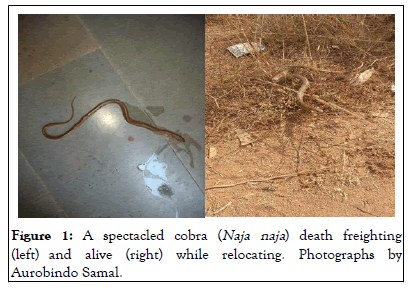Entomology, Ornithology & Herpetology: Current Research
Open Access
ISSN: 2161-0983
ISSN: 2161-0983
Short Communication - (2022)Volume 11, Issue 6
When an animal is threatened or attacked by a predator, it may appear to be dead by keeping a rigid posture or by mimicking entirely relaxed muscles (a behavior known as death feigning; also known as catalepsy, or tonic immobility; or letisimulation. Letisimulation is a common defensive behavior in which an animal pretends to die in order to avoid predation [1-5]. After all other anti-predator measures have failed. There are not many accounts that describe Thanatosis in Southern Asian snakes: Checkered keelback, Coelognathus radiatus, and the copperheaded trinket snake.
The spectacled cobra also called as common Indian cobra (Naja naja) (Figure 1) is a venomous elapid dwelling in a variety of natural habitats as well croplands and even near human habitations. Death feighning behavior has been described in several leptotyphlopid, colubrid and elapid snakes. Its range includes most of mainland India (excluding the Northeast), Pakistan, Nepal, Bhutan, Bangladesh, Sri Lanka, and possibly Eastern Afghanistan. Here, we present the first observation of a spectacled cobra exhibiting Thanatosis [6-11].

Figure 1: A spectacled cobra (Naja naja) death freighting (left) and alive (right) while relocating. Photographs by Aurobindo Samal.
The Naja naja's initial reaction to being disturbed is a swift escape, however if individuals are unable to do so. If disturbed further, it may strike or bite. Raising raise one-third of its body, lifting its hood, and hissing loudly. We received a rescue call on 24 December, 2021 from Bhubaneswar (20°15’ 19.0836”N 85°50’ 29.9796” E). Upon reaching the location we observed a spectacled cobra found dead (Figure 1), and it was decided to relocate the snake as for the villagers concern, after the rescue was been done and trans locating process, the snake was seen alive and healthy. The snake was relocated to a safer habitat.
The cobra was found showing feigned death, and unique behavior of thanatosis which is often a strategy to defend from predators. This is a first documentation of thanatosis behavior shown by a binocellate cobra in Bhubaneswar, India.
We are thankful to Earth Crusaders Organisation for their social awareness on wildlife from grassroot level and helping in drafting of this manuscript and also thankful to Bhubaneswar Judo Hall Association for calling us to rescue the snake.
Citation: Pandey S, Samal A, Pattnaik B (2022) Thanatosis Behavior: A Unique Strategy for Survival by a Spectacled Cobra, Naja naja (Linnaeus 1758) (Squamata: Elapidae) in Bhubaneswar, Odisha. Entomol Ornithol Herpetol. 11:292.
Received: 14-Jul-2022, Manuscript No. EOHCR-22-18394; Editor assigned: 16-Jul-2022, Pre QC No. EOHCR-22-18394(PQ); Reviewed: 01-Aug-2022, QC No. EOHCR-22-18394; Revised: 10-Oct-2022, Manuscript No. EOHCR-22-18394(R); Published: 17-Oct-2022 , DOI: 10.35248/2161-0983.22.11.292
Copyright: © 2022 Pandey S, et al. This is an open-access article distributed under the terms of the Creative Commons Attribution License, which permits unrestricted use, distribution, and reproduction in any medium, provided the original author and source are credited.